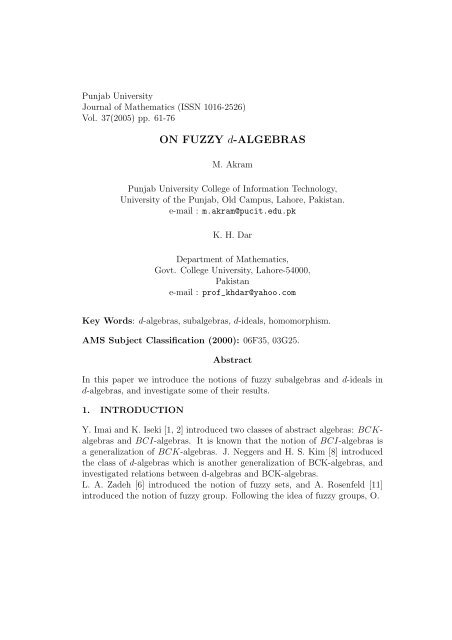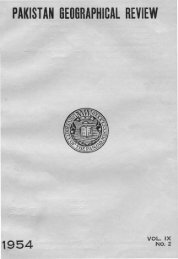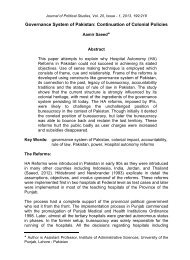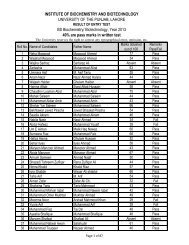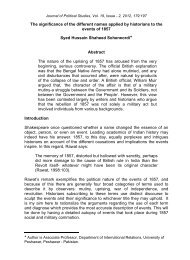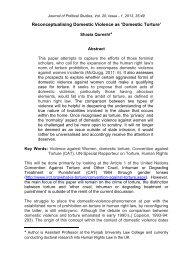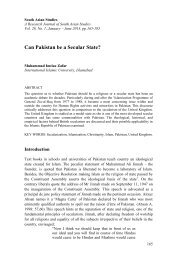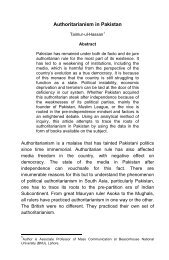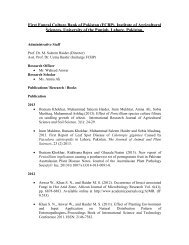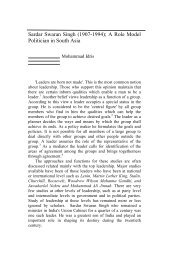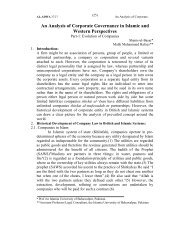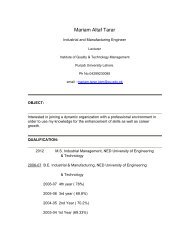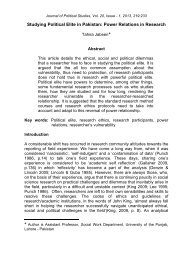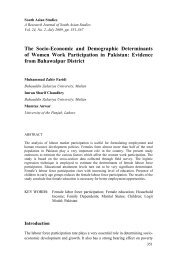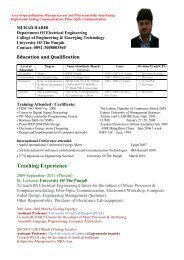ON FUZZY d-ALGEBRAS - University of the Punjab
ON FUZZY d-ALGEBRAS - University of the Punjab
ON FUZZY d-ALGEBRAS - University of the Punjab
Create successful ePaper yourself
Turn your PDF publications into a flip-book with our unique Google optimized e-Paper software.
<strong>Punjab</strong> <strong>University</strong><br />
Journal <strong>of</strong> Ma<strong>the</strong>matics (ISSN 1016-2526)<br />
Vol. 37(2005) pp. 61-76<br />
<strong>ON</strong> <strong>FUZZY</strong> d-<strong>ALGEBRAS</strong><br />
M. Akram<br />
<strong>Punjab</strong> <strong>University</strong> College <strong>of</strong> Information Technology,<br />
<strong>University</strong> <strong>of</strong> <strong>the</strong> <strong>Punjab</strong>, Old Campus, Lahore, Pakistan.<br />
e-mail : m.akram@pucit.edu.pk<br />
K. H. Dar<br />
Department <strong>of</strong> Ma<strong>the</strong>matics,<br />
Govt. College <strong>University</strong>, Lahore-54000,<br />
Pakistan<br />
e-mail : pr<strong>of</strong>_khdar@yahoo.com<br />
Key Words: d-algebras, subalgebras, d-ideals, homomorphism.<br />
AMS Subject Classification (2000): 06F35, 03G25.<br />
Abstract<br />
In this paper we introduce <strong>the</strong> notions <strong>of</strong> fuzzy subalgebras and d-ideals in<br />
d-algebras, and investigate some <strong>of</strong> <strong>the</strong>ir results.<br />
1. INTRODUCTI<strong>ON</strong><br />
Y. Imai and K. Iseki [1, 2] introduced two classes <strong>of</strong> abstract algebras: BCKalgebras<br />
and BCI-algebras. It is known that <strong>the</strong> notion <strong>of</strong> BCI-algebras is<br />
a generalization <strong>of</strong> BCK-algebras. J. Neggers and H. S. Kim [8] introduced<br />
<strong>the</strong> class <strong>of</strong> d-algebras which is ano<strong>the</strong>r generalization <strong>of</strong> BCK-algebras, and<br />
investigated relations between d-algebras and BCK-algebras.<br />
L. A. Zadeh [6] introduced <strong>the</strong> notion <strong>of</strong> fuzzy sets, and A. Rosenfeld [11]<br />
introduced <strong>the</strong> notion <strong>of</strong> fuzzy group. Following <strong>the</strong> idea <strong>of</strong> fuzzy groups, O.
62 M. Akram & K. H. Dar<br />
G. Xi [5] introduced <strong>the</strong> notion <strong>of</strong> fuzzy BCK-algebras. After that, Y. B.<br />
Jun and J. Meng [12] studied fuzzy BCK-algebras. B. Ahmad [10] fuzzified<br />
BCI-algebras. In this paper we fuzzify d-algebras.<br />
2. PRELIMINARIES<br />
In this section we cite <strong>the</strong> fundamental definitions that will be used in <strong>the</strong><br />
sequel:<br />
Definition 2.1<br />
An algebra (X; ∗, 0) <strong>of</strong> type (2, 0) is called a BCK-algebra if it satisfies <strong>the</strong><br />
following conditions:<br />
(1) ((x ∗ y) ∗ (x ∗ z)) ∗ (z ∗ y) = 0,<br />
(2) (x ∗ (x ∗ y)) ∗ y = 0,<br />
(3) x ∗ x = 0,<br />
(4) x ∗ y = 0,y ∗ x = 0 ⇒ x = y,<br />
(5) 0 ∗ x = 0<br />
for all x,y,z ∈ X.<br />
Definition 2.2<br />
Let X be a BCK-algebra and I be a subset <strong>of</strong> X, <strong>the</strong>n I is called an ideal <strong>of</strong><br />
X if<br />
(I1) 0 ∈ I,<br />
(I2) y and x ∗ y ∈ I ⇒ x ∈ I<br />
for all x,y ∈ X.<br />
Definition 2.3[8]<br />
A nonempty set X with a constant 0 and a binary operation ∗ is called a<br />
d-algebra , if it satisfies <strong>the</strong> following axioms:
On fuzzy d-algebras 63<br />
(d1) x ∗ x = 0,<br />
(d2) 0 ∗ x = 0,<br />
(d3) x ∗ y = 0 and y ∗ x = 0 ⇒ x = y<br />
for all x, y ∈ X.<br />
Definition 2.4[9]<br />
Let S be a non-empty subset <strong>of</strong> a d-algebra X, <strong>the</strong>n S is called subalgebra <strong>of</strong><br />
X if x ∗ y ∈ S, for all x,y ∈ S.<br />
Definition 2.5[9]<br />
Let X be a d-algebra and I be a subset <strong>of</strong> X, <strong>the</strong>n I is called d-ideal <strong>of</strong> X if<br />
it satisfies following conditions:<br />
(Id1) 0 ∈ I,<br />
(Id2) x ∗ y ∈ I and y ∈ I ⇒ x ∈ I,<br />
(Id3) x ∈ I and y ∈ X ⇒ x ∗ y ∈ I , i.e., I × X ⊆ I.<br />
Definition 2.6<br />
A mapping f : X → Y <strong>of</strong> d-algebras is called a homomorphism if f(x ∗ y) =<br />
f(x) ∗ f(y), for all x, y ∈ X.<br />
Note that if f : X → Y is homomorphism <strong>of</strong> d-algebras, <strong>the</strong>n f(0)= `0.<br />
Definition 2.7<br />
Let X be a non-empty set. A fuzzy (sub)set µ <strong>of</strong> <strong>the</strong> set X is a mapping<br />
µ : X → [0, 1].<br />
Definition 2.8<br />
Let µ be <strong>the</strong> fuzzy set <strong>of</strong> a set X. For a fixed s ∈ [0, 1], <strong>the</strong> set µs = {x ∈ X :<br />
µ(x) ≥ s} is called an upper level <strong>of</strong> µ.
64 M. Akram & K. H. Dar<br />
3. <strong>FUZZY</strong> SUB<strong>ALGEBRAS</strong><br />
Definition 3.1<br />
A fuzzy set µ in d-algebra X is called a fuzzy subalgebra <strong>of</strong> X if it satisfies<br />
µ(x ∗ y) ≥ min {µ(x),µ(y)}, for all x, y ∈ X.<br />
Example 3.2[8]<br />
Let X := {0, 1, 2} be a set given by <strong>the</strong> following Cayley table:<br />
* 0 1 2<br />
0 0 0 0<br />
1 2 0 2<br />
2 1 1 0<br />
Then (X; ∗, 0) is a d-algebra, but not a BCK-algebra, since (2 ∗ (2 ∗ 2)) ∗ 2 =<br />
(2 ∗ 0) ∗ 2 = 1 ∗ 2 = 2 �= 0. We define a fuzzy set µ : X → [0, 1] by µ(0) = 0.7,<br />
µ(x) = 0.02, where for all x �= 0 . It is easy to see that µ is a fuzzy subalgebra<br />
<strong>of</strong> X.<br />
Example 3.3<br />
Let X = {0, 1, 2, · · · } be a set and <strong>the</strong> operation ∗ be defined as follows:<br />
�<br />
0 if x ≤ y<br />
x ∗ y :=<br />
x − y if y < x<br />
Then (X; ∗, 0) is an infinite d-algebra. If we define a fuzzy set µ : X → [0, 1] by<br />
µ(0) = t1, µ(x) = t2 for all x �= 0, where t1 > t2. Then µ is a fuzzy subalgebra<br />
<strong>of</strong> X.<br />
Example 3.4<br />
Let X = {0, 1, 2, · · · } be a set and <strong>the</strong> operation ∗ be defined as follows:<br />
�<br />
0 if x ≤ y<br />
x ∗ y :=<br />
1 o<strong>the</strong>rwise<br />
Then (X; ∗, 0) is an infinite d-algebra, but not BCK-algebras, since (2 ∗ (2 ∗<br />
0)) ∗ 0 = (2 ∗ 1) ∗ 0 = 1 ∗ 0 = 1 �= 0.
On fuzzy d-algebras 65<br />
Example 3.5<br />
Let X = [0,a] ⊂ [0, 1], a being a fixed number, and <strong>the</strong> operation ∗ be defined<br />
as follows:<br />
x ∗ y = min(x,max(x,y) − min(x,y)), ∀x,y ∈ X.<br />
Then (X; ∗, 0) is an infinite d-algebra.<br />
Proposition 3.6<br />
A fuzzy set µ <strong>of</strong> a d-algebra X is a fuzzy subalgebra if and only if for every<br />
t ∈ [0, 1] <strong>the</strong> upper level µt is ei<strong>the</strong>r empty or a subalgebra <strong>of</strong> X.<br />
Pro<strong>of</strong><br />
Suppose that µ is a fuzzy subalgebra <strong>of</strong> a d-algebra X and µt �= 0, <strong>the</strong>n for any<br />
x,y ∈ µt, we have µ(x ∗ y) ≥ min {µ(x),µ(y)} ≥ t which implies x ∗ y ∈ µt,<br />
and hence µt is a subalgebra <strong>of</strong> X.<br />
Conversely, take t= min {µ(x),µ(y)}, for any x, y ∈ X. Then by assumption,<br />
µt is a subalgebra <strong>of</strong> X, which implies x ∗ y∈ µt, so that µ(x ∗ y) ≥ t= min<br />
{µ(x),µ(y)}. Hence µ is a fuzzy subalgebra <strong>of</strong> X.<br />
Proposition 3.7<br />
Any subalgebra <strong>of</strong> a d-algebra X can be realized as a level subalgebra <strong>of</strong> some<br />
fuzzy subalgebra <strong>of</strong> X.<br />
Pro<strong>of</strong><br />
Let A be a subalgebra <strong>of</strong> a d-algebra X and µ be a fuzzy set in X defined by<br />
�<br />
t, if x ∈ A;<br />
µ(x):=<br />
0, o<strong>the</strong>rwise.<br />
where t ∈ (0, 1). It is clear that µt = A. Let x, y ∈ X. If x, y ∈ A, <strong>the</strong>n<br />
x ∗ y ∈ A. So µ(x) = µ(y) = µ(x ∗ y) = t, and µ(x ∗ y) ≥min {µ(x),µ(y)}.<br />
If x, y /∈ A, <strong>the</strong>n µ(x) = µ(y) = 0. Thus µ(x ∗ y) ≥ min {µ(x),µ(y)} = 0.<br />
If at most one <strong>of</strong> x, y ∈ A, <strong>the</strong>n at least one <strong>of</strong> µ(x) and µ(y) is equal to 0.<br />
Therefore, min{µ(x),µ(y)}= 0 and µ(x ∗ y) ≥ 0 which completes <strong>the</strong> pro<strong>of</strong>.
66 M. Akram & K. H. Dar<br />
Corollary 3.8<br />
Let A be a subset <strong>of</strong> X. Then <strong>the</strong> characteristic function χA is a fuzzy subalgebra<br />
<strong>of</strong> X if and only if A is a subalgebra <strong>of</strong> X.<br />
Lemma 3.9<br />
Let µ be a fuzzy subalgebra with finite image. If µs = µt, for some s, t<br />
∈ Im(µ), <strong>the</strong>n s=t.<br />
Lemma 3.10<br />
Let µ and λ be two fuzzy subalgebras <strong>of</strong> X with identical family <strong>of</strong> level<br />
subalgebras. If Im(µ) = {t1,t2, · · · ,tn} and Im(λ)= {s1,s2, · · · ,sm}, where<br />
t1 ≥ t2 ≥ · · · tn and s1 ≥ s2 ≥ · · · sm. Then<br />
(1) m=n.<br />
(2) µti = λsi , for i= 1, 2, · · · , n.<br />
(3) If µ(x) = si, <strong>the</strong>n λ(x) = si , for all x ∈ X and i=1, 2, · · · , n.<br />
Proposition 3.11<br />
Let µ and λ be two fuzzy subalgebras <strong>of</strong> X with identical family <strong>of</strong> level<br />
subalgebras. Then µ = λ ⇒ Im(µ) = Im(λ).<br />
Pro<strong>of</strong><br />
Let Im(µ) = Im(λ) = {s1,...,sn} and s1 > ... > sn. By lemma 3.10, for any<br />
x ∈ X, <strong>the</strong>re exists si such that µ(x) = si = λ(x). Thus µ(x) = λ(x), ∀ x ∈ X.<br />
This completes <strong>the</strong> pro<strong>of</strong>.<br />
Proposition 3.12<br />
Two level subalgebras µs and µt, (s < t) <strong>of</strong> a fuzzy subalgebra are equal if and<br />
only if <strong>the</strong>re is no x ∈ X such that s ≤ µ(x) < t.
On fuzzy d-algebras 67<br />
Pro<strong>of</strong><br />
Suppose that µs = µt, for some s < t. If <strong>the</strong>re exists x ∈ X such that<br />
s ≤ µ(x) < t, <strong>the</strong>n µt is a proper subset <strong>of</strong> µs, which is contradicting <strong>the</strong><br />
hypo<strong>the</strong>sis.<br />
Conversely, suppose that <strong>the</strong>re is no x ∈ X such that s ≤ µ(x) < t. If x ∈ µs,<br />
<strong>the</strong>n µ(x) ≥ s and so µ(x) ≥ t, since µ(x) does not lie between s and t. Thus<br />
x ∈ µt, which gives µs ⊆ µt. The converse inclusion is obvious since s < t.<br />
Therefore, µs = µt.<br />
4. <strong>FUZZY</strong> d - IDEALS<br />
Definition 4.1<br />
A fuzzy set µ in X is called fuzzy BCK-ideal <strong>of</strong> X if it satisfies <strong>the</strong> following<br />
inequalities:<br />
(1) µ(0) ≥ µ(x),<br />
(2) µ(x) ≥ min{µ(x ∗ y),µ(y)} , for all x, y ∈ X.<br />
Definition 4.2<br />
A fuzzy set µ in X is called fuzzy d-ideal <strong>of</strong> X if it satisfies <strong>the</strong> following<br />
inequalities:<br />
(Fd1) µ(0) ≥ µ(x),<br />
(Fd2) µ(x) ≥ min{µ(x ∗ y),µ(y)},<br />
(Fd3) µ(x ∗ y) ≥ min{µ(x),µ(y)}<br />
for all x, y ∈ X.
68 M. Akram & K. H. Dar<br />
Example 4.3[11]<br />
Let X := {0, 1, 2, 3} be a d-algebra with <strong>the</strong> following Cayley table:<br />
* 0 1 2 3<br />
0 0 0 0 0<br />
1 1 0 0 1<br />
2 2 2 0 0<br />
3 3 3 3 0<br />
Then (X; ∗, 0) is not BCK-algebra since {(1 ∗ 3) ∗ (1 ∗ 2)} ∗ (2 ∗ 3) = 1 �= 0.<br />
We define fuzzy set µ in X by µ(0) = 0.8 and µ(x) = 0.01, for all x �= 0 in X.<br />
Then it is easy to show that µ is a d-ideal <strong>of</strong> X.<br />
We can easily observe <strong>the</strong> following propositions:<br />
• In a d-algebra every fuzzy d-ideal is a fuzzy BCK-ideal, and every fuzzy<br />
BCK-ideal is a fuzzy d-subalgebra.<br />
• Every fuzzy d-ideal <strong>of</strong> a d-algebra is a fuzzy d-subalgebra.<br />
Theorem 4.4<br />
If each non-empty level subset U(µ;t) <strong>of</strong> µ is a fuzzy ideal <strong>of</strong> X <strong>the</strong>n µ is a<br />
fuzzy d-ideal <strong>of</strong> X, where t ∈ [0, 1].<br />
Pro<strong>of</strong><br />
Assume that each non-empty level subset U(µ;s) <strong>of</strong> µ is a d-ideal. Then it is<br />
easy to show that µ satisfies (Fd1)and (Fd2). Assume that µ(x ∗ y) < min<br />
{µ(x),µ(y)}, for some x, y ∈ X. Take t0 := 1{µ(x<br />
∗ y) + min (µ(x),µ(y))},<br />
2<br />
<strong>the</strong>n x, y ∈ U(µ;t0). Since µ is a d-ideal <strong>of</strong> X, x ∗ y ∈ U(µ;t0), <strong>the</strong>refore,<br />
µ(x ∗ y) ≥ t0 , a contradiction. Hence assumption is wrong. This completes<br />
<strong>the</strong> pro<strong>of</strong>.<br />
Definition 4.5[4]<br />
Let λ and µ be <strong>the</strong> fuzzy sets in a set X. The cartesian product λ × µ :<br />
X × X −→ [0, 1] is defined by (λ × µ)(x,y)= min{λ(x),µ(x)}, ∀ x, y ∈ X.
On fuzzy d-algebras 69<br />
Theorem 4.6<br />
If λ and µ are fuzzy d-ideals <strong>of</strong> a d-algebra X. Then λ × µ is a fuzzy d-ideal<br />
<strong>of</strong> X × X.<br />
Pro<strong>of</strong><br />
For any (x,y) ∈ X × X, we have<br />
(λ × µ)(0, 0)= min {λ(0),µ(0)} ≥ min {λ(x),µ(y)} = (λ × µ)(x,y)<br />
Let (x1,x2) and (y1,y2) ∈ X × X. Then<br />
(λ × µ)((x1,x2))= min {λ(x1),µ(x2)}<br />
≥ min { min {λ(x1 ∗ y1),λ(y1)}, min {µ(x2 ∗ y2),µ(y2)}}<br />
= min { min {λ(x1 ∗ y1),µ(x2 ∗ y2)}, min {λ(y1),µ(y2)}}<br />
= min {(λ × µ)((x1 ∗ y1,x2 ∗ y2)), (λ × µ)((y1,y2))}<br />
= min {(λ × µ)((x1,x2) ∗ (y1,y2)), (λ × µ)((y1,y2))}<br />
and (λ × µ)((x1,x2) ∗ (y1,y2))= (λ × µ)((x1 ∗ y1,x2 ∗ y2))<br />
= min {λ(x1 ∗ y1),µ(x2 ∗ y2)}<br />
≥ min { min {λ(x1),λ(y1)}, min {µ(x2),µ(y2)}}<br />
= min { min {λ(x1),µ(x2)}, min {λ(y1),µ(y2)}}<br />
= min {(λ × µ)((x1,x2)), (λ × µ)((y1,y2))}.<br />
Hence λ × µ is a fuzzy d−ideal <strong>of</strong> X × X.<br />
Theorem 4.7<br />
Let λ and µ be fuzzy sets in a d-algebra X such that λ × µ is a fuzzy d-ideal<br />
<strong>of</strong> X × X. Then<br />
(i) ei<strong>the</strong>r λ(0) ≥ λ(x) or µ(0) ≥ µ(x), ∀x ∈ X.<br />
(ii) If λ(0) ≥ λ(x), ∀x ∈ X, <strong>the</strong>n ei<strong>the</strong>r µ(0) ≥ λ(x) or µ(0) ≥ µ(x).<br />
(iii) If µ(0) ≥ µ(x), ∀x ∈ X, <strong>the</strong>n ei<strong>the</strong>r λ(0) ≥ λ(x) or λ(0) ≥ µ(x).
70 M. Akram & K. H. Dar<br />
Pro<strong>of</strong><br />
(i) We prove it using reductio ad absurdum.<br />
Assume λ(x) > λ(0) and µ(y) > µ(0), for some x, y ∈ X. Then<br />
(λ × µ)(x,y) = min {λ(x),µ(y)} > min {λ(0),µ(0)} = (λ × µ)(0, 0)<br />
⇒ (λ × µ)(x,y) > (λ × µ)(0, 0), ∀ x, y ∈ X.<br />
which is a contradiction. Hence (i) is proved.<br />
(ii) Again, we use reduction to absurdity.<br />
Assume µ(0) < λ(x) and µ(0) < µ(y), ∀ x, y ∈ X. Then,<br />
(λ × µ)(0, 0)= min {λ(0),µ(0)} = µ(0)<br />
and (λ × µ)(x, y) = min {λ(x), µ(y)} > µ(0) = (λ × µ)(0, 0)<br />
⇒ (λ × µ)(x, y) > (λ × µ)(0, 0).<br />
which is a contradiction. Hence (ii) is proved.<br />
(iii) The pro<strong>of</strong> is similar to (ii).<br />
The partial converse <strong>of</strong> <strong>the</strong> Theorem 4.6 is <strong>the</strong> following.<br />
Theorem 4.8<br />
If λ × µ is a fuzzy d-ideal <strong>of</strong> X × X, <strong>the</strong>n λ or µ is a fuzzy d-ideal <strong>of</strong> X.<br />
Pro<strong>of</strong><br />
By Theorem 4.7(i), without loss <strong>of</strong> generality we assume that µ(0) ≥ µ(x), ∀<br />
x ∈ X.<br />
It follows from Theorem 4.7(iii) that ei<strong>the</strong>r λ(0) ≥ λ(x) or λ(0) ≥ µ(x). If<br />
λ(0) ≥ µ(x), ∀ x ∈ X. Then (λ × µ)(0,x)= min {λ(0),µ(x)} = µ(x) − − (A)<br />
Since λ × µ is a fuzzy d-ideal <strong>of</strong> X × X, <strong>the</strong>refore,<br />
(λ × µ)(x1,x2) ≥ min {(λ × µ)((x1,x2) ∗ (y1,y2)), (λ × µ)(y1,y2)}<br />
and (λ × µ)((x1,x2) ∗ (y1,y2)) ≥ min {(λ × µ)((x1,x2), (λ × µ)((y1,y2)}<br />
It implies that (λ×µ)(x1,x2) ≥ min {(λ×µ)((x1 ∗y1,x2 ∗y2)), (λ×µ)(y1,y2)}.
On fuzzy d-algebras 71<br />
and (λ × µ)((x1 ∗ y1,x2 ∗ y2)) ≥ min {(λ × µ)((x1,x2), (λ × µ)((y1,y2)}.<br />
Putting x1=y1=0, we have<br />
(λ × µ)(0,x2) ≥ min {(λ × µ)((0,x2 ∗ y2)), (λ × µ)(0,y2)}<br />
and (λ × µ)((0,x2 ∗ y2)) ≥ min {(λ × µ)((0,x2), (λ × µ)((0,y2)}<br />
using equation(A), we have<br />
µ(x2) ≥ min{µ(x2 ∗ y2),µ(y2)}<br />
and µ(x2 ∗ y2) ≥ min{µ(x2),µ(y2)}.<br />
This proves that µ is a fuzzy d-ideal <strong>of</strong> X. The second part is similar. This<br />
completes <strong>the</strong> pro<strong>of</strong>.<br />
Definition 4.9[4]<br />
Let A be a fuzzy set in a set S, <strong>the</strong> strongest fuzzy relation on S that is fuzzy<br />
relation on A is µA given by µA(x,y)= min{A(x),A(y)}, for all x, y ∈ S.<br />
Theorem 4.10<br />
Let A be a fuzzy set in a d-algebra X and µA be <strong>the</strong> strongest fuzzy relation<br />
on X. Then A is a fuzzy d-ideal <strong>of</strong> X if and only if µA is a fuzzy d-ideal <strong>of</strong><br />
X × X.<br />
Pro<strong>of</strong><br />
Suppose that A is a fuzzy d-ideal <strong>of</strong> X. Then<br />
µA(0, 0)= min{A(0),A(0)} ≥ min {A(x),A(y)}= µA(x,y), ∀ (x,y) ∈ X × X.<br />
For any x = (x1,x2) and y = (y1,y2)∈ X × X, we have<br />
µA(x) = µA(x1,x2)= min {A(x1),A(x2)}<br />
≥ min { min {A(x1 ∗ y1),A(y1)}, min {A(x2 ∗ y2),A(y2)}}<br />
= min { min {A(x1 ∗ y1),A(x2 ∗ y2)}, min {A(y1),A(y2)}}<br />
=min {µA(x1 ∗ y1,x2 ∗ y2),µA(y1,y2)}<br />
= min {µA((x1,x2) ∗ (y1 ∗ y2)),µA(y1,y2)}<br />
= min {µA(x ∗ y),µA(y)}
72 M. Akram & K. H. Dar<br />
and µA(x ∗ y) = µA((x1,x2) ∗ (y1,y2))<br />
= µA((x1 ∗ y1,x2 ∗ y2))<br />
= min {A(x1 ∗ y1),A(x2 ∗ y2)}<br />
≥ min {min {A(x1),A(y1)}, min {A(x2),A(y2)}}<br />
= min { min {A(x1),A(x2)}, min {A(y1),A(y2)}}<br />
= min {µA((x1,x2),µA(y1,y2)}<br />
= min {µA(x),µA(y)}.<br />
Hence µA is a fuzzy d-ideal <strong>of</strong> X × X.<br />
Conversely, suppose that µA is a fuzzy d-ideal <strong>of</strong> X × X. Then<br />
min{A(0),A(0)} = µA(0, 0)≥ µA(x,y)= min {A(x),A(y)}, ∀ (x,y) ∈ X × X.<br />
It follows that A(x) ≤ A(0), ∀x ∈ X<br />
For any x = (x1,x2), y = (y1,y2)∈ X × X, we have<br />
min{A(x1),A(x2)}= µA(x1,x2)<br />
≥ min {µA((x1,x2) ∗ (y1,y2)),µA(y1,y2)}<br />
= min {µA(x1 ∗ y1,x2 ∗ y2),µA(y1,y2)}<br />
= min {min{A(x1 ∗ y1),A(x2 ∗ y2)}, min{A(y1),A(y2)}}<br />
= min {min{A(x1 ∗ y1),A(y1)}, min {A(x2 ∗ y2),A(y2)}}.<br />
Putting x2=y2=0, we have<br />
µA(x1) ≥ min {µA(x1 ∗ y1),µA(y1)}.<br />
Likewise, µA(x1 ∗ y1) ≥ min {µA(x1),µA(y1)}.<br />
Hence A is fuzzy d-ideal <strong>of</strong> X.<br />
Definition 4.11<br />
Let f : X −→ Y be a mapping <strong>of</strong> d-algebras and µ be a fuzzy set <strong>of</strong> Y . The<br />
map µ f is <strong>the</strong> pre-image <strong>of</strong> µ under f, if µ f (x) = µ(f(x)), ∀ x ∈ X.<br />
Theorem 4.12<br />
Let f : X −→ Y be a homomorphism <strong>of</strong> d-algebras. If µ is a fuzzy d-ideal <strong>of</strong>
On fuzzy d-algebras 73<br />
Y , <strong>the</strong>n µ f is a fuzzy d-ideal <strong>of</strong> X.<br />
Pro<strong>of</strong><br />
For any x ∈ X, we have<br />
µ f (x) = µ(f(x)) ≤ µ(´0) = µ(f(0)) = µ f (0)<br />
Let x, y ∈ X. Then<br />
min {µ f (x ∗ y),µ f (y)}<br />
= min {µ(f(x ∗ y)),µ(f(y))}<br />
=min {µ(f(x) ∗ f(y)),µ(f(y))}<br />
≤ µ(f(x)) = µ f (x)<br />
and min {µ f (x),µ f (y)}<br />
= min {µ(f(x)),µ(f(y))}<br />
=min {µ(f(x)),µ(f(y))}<br />
≤ µ(f(x) ∗ f(y)) = µ(f(x ∗ y)) = µ f (x ∗ y).<br />
Hence µ f is a fuzzy d- ideal <strong>of</strong> X.<br />
Theorem 4.13<br />
Let f : X −→ Y be an epimorphism <strong>of</strong> d-algebras. If µ f is a fuzzy d-ideal <strong>of</strong><br />
X, <strong>the</strong>n µ is a fuzzy d-ideal <strong>of</strong> Y .<br />
Pro<strong>of</strong><br />
Let y ∈ Y , <strong>the</strong>re exists x ∈ X such that f(x) = y. Then<br />
µ(y) = µ(f(x)) = µ f (x) ≤ µ f (0) = µ(f(0)) = µ(´0)<br />
Let x, y ∈ Y . Then <strong>the</strong>re exist a, b ∈ X such that f(a) = x and f(b) = y. It<br />
follows that µ(x) = µ(f(a)) = µ f (a)<br />
≥ min {µ f (a ∗ b),µ f (b)}<br />
= min {µ(f(a ∗ b)),µ(f(b))}<br />
= min {µ(f(a) ∗ f(b)),µ(f(b))}<br />
= min {µ(x ∗ y),µ(y)}
74 M. Akram & K. H. Dar<br />
and µ(x ∗ y) = µ(f(a) ∗ f(b)) = µ f (a ∗ b)<br />
≥ min {µ f (a),µ f (b)}<br />
= min {µ(f(a)),µ(f(b))}<br />
= min {µ(x),µ(y)}.<br />
Hence µ is a fuzzy d- ideal <strong>of</strong> Y .<br />
Acknowledgements: The authors wish to express <strong>the</strong>ir sincere thanks to<br />
Pr<strong>of</strong>essor Hee Sik Kim for his moral support. The research work <strong>of</strong> second<br />
author is supported by HEC-Islamabad, Pakistan. Authors are also thankful<br />
to <strong>the</strong> referee for his useful suggestions.<br />
References<br />
[1] Y. Imai and K. Iseki, On axiom systems <strong>of</strong> propositional calculi XIV,<br />
Proc. Japan Acad 42 (1966), 19-22.<br />
[2] K. Iseki,An algebra related with a propositional calculus, Proc. Japan<br />
Acad 42 (1966), 26-29.<br />
[3] W. A. Dudek , Y. B. Jun and Z. Stojakovic, On fuzzy ideals in BCCalgebras,<br />
Fuzzy sets and System, 123(2001) 251-258.<br />
[4] P. Bhattacharya and N. P. Mukherjee, Fuzzy relations and fuzzy groups,<br />
Inform. Sci. 36(1985), 267-282.<br />
[5] O. G. Xi, Fuzzy BCK-algebras, Math. Japon., 36(1991), 935-942.<br />
[6] L. A. Zadeh, Fuzzy sets, Information Control, 8(1965) 338-353.<br />
[7] K-Iseki and S.Tanaka, Ideal <strong>the</strong>ory <strong>of</strong> BCK-algebras, Math. Japonica,<br />
21(1976), 351-366.<br />
[8] J. Neggers and H. S. Kim, On d-algebras, Math. Slovaca , 49(1999),<br />
19-26.<br />
[9] J. Neggers , Y. B. Jun and H. S. Kim, On d-ideals in d-algebras, Math.<br />
Slovaca, 49(1999), 243-251.<br />
[10] B. Ahmad, Fuzzy BCI-algebras, J. Fuzzy Math 2(1993), 445-452.
On fuzzy d-algebras 75<br />
[11] A. Rosenfeld, Fuzzy groups, J. Math. Anal. Appl. 35 (1971), 512–517.<br />
[12] Y. B. Jun and J. Meng, Characterization <strong>of</strong> fuzzy subalgebras by <strong>the</strong>ir<br />
level subalgebras, Selected papers on BCK- and BCI-algebras, 1(1992),<br />
60-65, Shanxi Sci. Tech. Press (in china).
76 M. Akram & K. H. Dar


